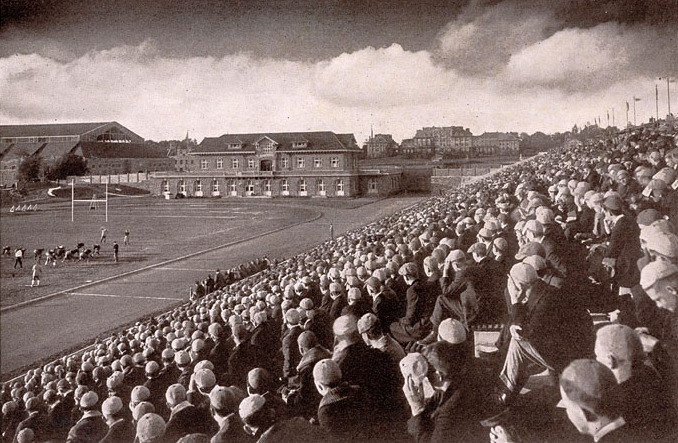|
Skullcap (other)
Skullcap or skull cap usually refers to various types of headgear. Specifically it may refer to: Headwear * Beanie (seamed cap) * Biretta, forming part of some clerical, academic or legal dress * Calotte (Belgium), a skullcap worn by students at Catholic universities in Belgium * Capeline, worn under civilian hats during early modern periods * Cervelliere, a medieval metal helmet * Jeep cap * Kippah or yarmulke, worn by Jewish men * Kufi, worn primarily by men of West African heritage * Scrum cap, worn by rugby players * Sindhi cap worn by Sindhi people of Pakistan, and others * Scrubs (clothing)#Scrub caps, worn by healthcare professionals while performing procedures * Taqiyah (cap), worn by some Muslim men * Tubeteika, a Central Asian cap * Tuque, a knit hat * Zucchetto, worn by Catholic clergy Plants * ''Galerina marginata'', a poisonous mushroom also known as "deadly skullcap" or "autumn skullcap" * ''Scutellaria'', a genus of flowering plants also known as "skullcaps" ** '' ... [...More Info...] [...Related Items...] OR: [Wikipedia] [Google] [Baidu] |
Headgear
Headgear, headwear, or headdress is the name given to any element of clothing which is worn on one's head, including hats, helmets, turbans and many other types. Headgear is worn for many purposes, including protection against the elements, decoration, or for religious or cultural reasons, including social conventions. Purposes Protection or defence Headgear may be worn for protection against cold (such as the Canadian tuque), heat, rain and other precipitation, glare, sunburn, sunstroke, dust, contaminants, etc. Helmets are worn for protection in battle or against impact, for instance when riding bicycles or motor vehicles. There are also hats that are worn for protection from the cold. Fashion Headgear can be an article of fashion, usually hats, caps or hoods. The formal man's black silk top hat was formerly an indispensable portion of the suit, and women's hats have, over the years, attained a fantastic number of shapes ranging from immense confections to ... [...More Info...] [...Related Items...] OR: [Wikipedia] [Google] [Baidu] |
Scrubs (clothing)
Scrubs are the sanitary clothing worn by physicians, nurses, dentists and other workers involved in patient care. Originally designed for use by surgeons and other operating room personnel, who would put them on when sterilizing themselves, or "scrubbing in", before surgery, they are now worn by many hospital personnel. Their use has been extended outside hospitals as well, to work environments where clothing may come into contact with infectious agents (veterinarians, midwives, etc.). Scrubs are designed to be simple (with minimal places for contaminants to hide), easy to launder, and cheap to replace if damaged or stained irreparably. In the United Kingdom, scrubs are sometimes known as theatre blues. The spread of methicillin-resistant ''Staphylococcus aureus'' (MRSA) has increased the use of scrubs but can give wearers a false sense of security that they are 'clean' when in fact they are as easily contaminated as any other clothing. History of surgical attire In cont ... [...More Info...] [...Related Items...] OR: [Wikipedia] [Google] [Baidu] |
Scutellaria Baicalensis
''Scutellaria baicalensis'', with the common name Baikal skullcap or Chinese skullcap, is a species of flowering plant in the family Lamiaceae. Distribution The plant is native to China, Korea, Mongolia, and Russia in the Russian Far East and Siberia. Medicinal plant Traditional Chinese medicine It is one of the 50 fundamental herbs used in traditional Chinese medicine, where it has the name ''huángqín'' (). As a Chinese traditional medicine, ''huang qin'' usually refers to the dried root of ''S. baicalensis'' Georgi, ''S. viscidula'' Bge., ''S. amoena'' C.H. Wright, and ''S. ikoninkovii'' Ju. Its use in TCM is for "the prophylaxis and treatment of hepatitis, atherosclerosis, hypertension, hyperlipidemia, type 2 diabetes, dysentery, ulcerative colitis, and respiratory disorders." Pharmacology Several chemical compounds have been isolated from the root; baicalein, baicalin, wogonin, norwogonin, oroxylin A and β-sitosterol are the major ones. Names It is important to us ... [...More Info...] [...Related Items...] OR: [Wikipedia] [Google] [Baidu] |
Scutellaria
''Scutellaria'' is a genus of flowering plants in the mint family, Lamiaceae. They are known commonly as skullcaps. The generic name is derived from the Latin ''scutella'', meaning "a small dish, tray or platter",''Scutellaria parvula'' var. ''missouriensis''. Robert W. Freckmann Herbarium. University of Wisconsin, Stevens Point. or "little dish", referring to the shape of the calyx. The common name alludes to the resemblance of the same structure to "miniature ". The genus has a [...More Info...] [...Related Items...] OR: [Wikipedia] [Google] [Baidu] |
Galerina Marginata
''Galerina marginata'', known colloquially as funeral bell, deadly skullcap, autumn skullcap or deadly galerina, is a species of extremely poisonous mushroom-forming fungus in the family Hymenogastraceae of the order Agaricales. It contains the same deadly amatoxins found in the death cap ('' Amanita phalloides''). Ingestion in toxic amounts causes severe liver damage with vomiting, diarrhea, hypothermia, and eventual death if not treated rapidly. About ten poisonings have been attributed to the species now grouped as ''G. marginata'' over the last century. ''G. marginata'' is widespread in the Northern Hemisphere, including Europe, North America, and Asia, and has also been found in Australia. It is a wood-rotting fungus that grows predominantly on decaying conifer wood. The fruit bodies of the mushroom have brown to yellow-brown caps that fade in color when drying. The gills are brownish and give a rusty spore print. A well-defined membranous ring is typicall ... [...More Info...] [...Related Items...] OR: [Wikipedia] [Google] [Baidu] |
Zucchetto
The zucchetto (, also ,"zucchetto" (US) and , ; meaning "small ", from ''zucca'', ""; plural in English: zucchettos) or solideo, officially a pileolus, is a small, hemispherical, form-fitting ecclesiastical skullcap worn by of various |
Tuque
A knit cap is a piece of knitted headwear designed to provide warmth in cold weather. It usually has a simple tapered shape, although more elaborate variants exist. Historically made of wool, it is now often made of synthetic fibers. Found all over the world where the climate demands warm clothing, knit caps are known by a variety of local names. In American English this type of hat is known as a ''beanie'' or a "watch cap,", while in Canadian English, a knit cap is known as a ', ', or ' (pronounced ). Construction Most knit caps are tapered at the top. The stretch of the knitting itself hugs the head, keeping the cap secure. They are sometimes topped with a pom-pom or loose tassels. Knit caps may have a folded brim, or none, and may be worn tightly fitting the head or loose on top. A South American tradition from the Andes Mountains is for the cap to have ear flaps, with strings for tying under the chin. A special type of cap called a balaclava folds down over the head ... [...More Info...] [...Related Items...] OR: [Wikipedia] [Google] [Baidu] |
Tubeteika
A tubeteika ( rus, тюбете́йка, links=1, tyubeteika, tʲʉbʲɪˈtʲeɪ̯kə, LL-Q8798 (ukr)-Tohaomg-тюбетейка.wav) is a Russian word for many varieties of traditional Central Asian caps. Tubeteikas are today worn in Tajikistan, Kazakhstan, Kyrgyzstan, and Uzbekistan, as well as in Muslim-populated regions of Russia (mainly Tatars) and Azerbaijan. The skullcap worn by Uzbeks and Uyghurs is called a doppa and has a square base. It was a popular headgear among children throughout the USSR during the 1940s and 1950s. Tubeteikas are worn typically by the Turkic ethnic groups of the region. It bears some superficial resemblance to the yurt, another Central Asian cultural icon. The ''-ka'' at the end is a Russian diminutive suffix, as with '' shapka'', ''ushanka'' and ''budenovka''. In Turkmen, it is called ''tahiya'' ("taqiyah"). Doppa The Uzbek ''doppa'' or ''duppi'' ( uz, doʻppi) is considered an applied art form and an important part of the traditional fol ... [...More Info...] [...Related Items...] OR: [Wikipedia] [Google] [Baidu] |
Taqiyah (cap)
The Taqiyah ( ar, طاقية, ALA-LC: ''ṭāqīyah''Turkish: "takke", Urdu, Hindi "topi", , ALA-LC: "ṭopī", bn, টুপি, ''ṭupi'', Somali: "Koofi")) or araqchin () is a short, rounded skullcap. It is often worn for religious purposes; for example, Muslims believe that the Islamic prophet Muhammad used to keep his head covered, therefore making it ''mustahabb'' (i.e., it is commendable to cover the head in order to emulate him). Muslim men often wear them during the five daily prayers. When worn by itself, the taqiyah can be any color. However, particularly in Arab countries, when worn under the keffiyeh headscarf, they are kept in a traditional white. Some Muslims wrap a turban around the cap, called an ''ʿimamah'' in Arabic, which is often done by Shia and Sunni Muslims. In the United States and Britain, taqiyas are usually referred to as " kufis". Topi is a type of taqiyah cap that is worn in Pakistan, Bangladesh, India, and other regions of South Asia. Many ... [...More Info...] [...Related Items...] OR: [Wikipedia] [Google] [Baidu] |
Sindhi Cap
The Sindhi cap, also known as the Sindhī ṭopī () rarely known as the Sindhi Kufi ( sd, سنڌي ڪفي), is a skullcap worn predominantly by Sindhis in Sindh, Pakistan. Together with Ajrak or Saraiki Ajrak, the Sindhi cap is regarded as an essential part of Sindhi Saraiki culture, and Balochi culture. History The Sindhi cap originated during the time of the Kalhoras, but came into general use under the Talpurs. It was widely worn in Sindh by all except religious persons, who wore the turban. It was primarily associated with the higher classes, both Sindhi Muslims and Sindhi Hindus, specially the Amil caste. In Sindhi culture, the Sindhi cap is often given as a gift or as a sign of respect, along with the traditional Ajrak. Hand-woven Sindhi caps are a product of hard labour, and are primarily produced in Tharparkar, Umerkot, Sanghar and other districts of the Mirpurkhas division of Sindh. The Sindhi cap, along with Ajrak, is specially celebrated on Sindhi Cultural ... [...More Info...] [...Related Items...] OR: [Wikipedia] [Google] [Baidu] |
Beanie (seamed Cap)
In the United States, a beanie is a head-hugging brimless cap, sometimes made from triangular panels of material joined by a button at the crown and seamed together around the sides. Beanies may be made of cloth, felt, wool, leather, or silk. In many US regions and parts of Canada the term "beanie" refers to a knitted cap (often woollen), alternately called a "stocking cap" or (especially in Canada) a "toque". Styles One popular style of the beanie during the early half of the twentieth century was a kind of skullcap made of four or six felt panels sewn together to form the cap. The panels were often composed of two or more different contrasting colors to give them a novel and distinctive look. This type of beanie was also very popular with some colleges and fraternities, as they would often use school colors in the different panels making up the headgear. Another style of beanie was the whoopee cap, a formed and pressed wool felted hat, with a flipped up brim that forme ... [...More Info...] [...Related Items...] OR: [Wikipedia] [Google] [Baidu] |
Scrum Cap
The scrum cap is a form of headgear used by rugby players to protect the ears in the scrum, which can otherwise suffer injuries leading to the condition commonly known as cauliflower ears. Although originally designed for forwards they are now worn by players of all positions, even those who do not play in the scrum. A simpler alternative to a cap, or a head-cap and used by many players, is a thin strip of foam or cloth and electrical tape wrapped around the ears like a head band. Construction The scrum cap was first used by the Christ's College Finchley's 1st XV, and Eurig Evans is credited with its design. The traditional scrum cap was constructed of a thin cloth helmet with padding over the ears, held in place by a strap—but modern models are typically made from thin foam. The headgear is defined by Regulation 12 [...More Info...] [...Related Items...] OR: [Wikipedia] [Google] [Baidu] |






.jpg)

.jpg)